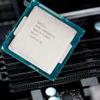Pentium 20th Anniversary
Pentium 20th Anniversary
It has been a long ride for Intel Pentium processors, and though they are still around, they have NOTHING in common with the initial releases of Pentium.
The name Pentium is originally derived from the Greek word pente, meaning "five" (as the original Pentium processors used Intel's fifth-generation microarchitecture, the P5), and the Latin ending -ium. The current Pentium processors only share the name but are in fact based on the same processor chips that are used in the Intel Core but are typically used with a lowerclock frequency, a partially disabled L3 cache and some of the advanced features such as hyper-threading and virtualization disabled.
Quick flashback:
| Core | Process | Frequency | L1 Cache | FSB | Socket | Release date |
|---|---|---|---|---|---|---|
| P5 | 0.8 µm | 60–66 MHz | 16 KB | 60–66 MHz | Socket 4 | March 1993 |
| P54C | 0.6 µm | 75–120 MHz | 16 KB | 50–66 MHz | Socket 5 | October 1994 |
| P54CS | 0.35 µm | 133–200 MHz | 16 KB | 60–66 MHz | Socket 7 | June 1995 |
| P55C | 0.35 µm | 120–233 MHz | 32 KB | 60–66 MHz | Socket 7 | January 1997 |
| Tillamook | 0.25 µm | 166–300 MHz | 32 KB | 66 MHz | Socket 7 | August 1997 |
The original Pentium and Pentium MMX processors were the superscalar follow-on to the 80486 processor and were marketed from 1993 to 1999. Some versions of these were available as Pentium OverDrive that would fit into older CPU sockets. If you have been in the business (are as old) as long as I am, then you might remember that the first Pentium processors ran at 60 and 66 MHz, and that there was a bug in them that produced compute errors. Other then that, Pentium has been a success story ever since the beginning that over the years evolved into more energy friendly Banias architecture based processor, and sure in the end Pentium has been the building block for the current Core series processors. To this very date Intel kept the Pentium branding alive and kicking, though the brand and SKUs are aimed at a entry-level solutions that sit in between Celeron and Core i3 processors performance and pricing wise.

Does anyone remember what the Pentium II looked like back in the days ? :)
G3258 20th Anniversary Edition
The rule to the exception is the product we review today. The G3258 20th Anniversary Edition is unique in the sense that it is a K model processors, which opens up the Pentium architecture multipliers, and that means more easy overclocking. And it is interesting, as Intel thus far only has released K model processors in the high-end segment. So now you can go nuts with a 60 EURO processors, and if your break it... at least you won't have broken the bank, eh? What's interesting to know is that the Pentium G3258 20th Anniversary Edition processor actually is based upon Haswell architecture. The Processor offers two physical CPU cores that will run on a base-clock of 3.2 GHz. There's no hyper-threading and there is no Turbo mode available. Another difference is of course the internal cache memory, 3 MB L3 cache is available. Being Haswell based, the processor does come with an integrated GPU as well, Intel HD Graphics. It comes with 10 execution units, where the common Intel HD 4600 IGPs on the Core i7 series have 20 execution units. So that's cut in half as well. One other thing, the Pentium processors typically do not have Quick Sync functionality, the G3258 Anniversary Edition however has this functionality enabled. The TDP of the processor is 53 Watt.
What Is Tested Today?
Today we test the Pentium G3258 20th Anniversary Edition, it is the new two-core flagship in the Pentium line and the only K model processor in this class.
| Desktop | Cores | Threads | Clock Core / Boost | L3 cache | iGPU | Unlocked |
| Core i7-4790K | 4 | 8 | 4.0 GHz/ 4.4 GHz | 8 MB | HD 4600 | Yes |
| Core i7-4790 | 4 | 8 | 3.6 GHz/ 4.0 GHz | 8 MB | HD 4600 | No |
| Core i5-4770K | 4 | 4 | 3.5 GHz/ 3.9 GHz | 8 MB | HD 4600 | Yes |
| Pentium G3258 | 2 | 2 | 3.2 GHz/ -- | 3 MB | HD Graphics | Yes |
So basically the Pentium G3258 20th Anniversary Edition, is an entry level processor, excellent for a net-top, HTPC and small server with say NAS functionality. However, being a K model does make this product very interesting. Would you like to find out how it will behave in performance?
What about motherboards? You need to remember that K model processors require a Z87 or Z97 motherboard, supporting this processor (check the motherboard manufacturer for a BIOS update). There are some other models and hacked BIOSes out there that will allow you to OC with this SKU just as well of course.


